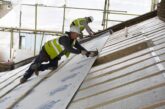
James Hulbert, Head of Housing at Knauf Insulation explains what you need to know to make sure you don’t fall foul of the new regulations.
Regulations are changing to improve the energy efficiency of homes and buildings in the UK, changes that could have far-reaching consequences for builders. The long-anticipated update to Part L of the Building Regulations in England and Wales will be the first step on the ladder to stricter thermal performance measures. It will feed into the more rigorous Future Homes Standard.
Part L 2021 will require a combination of fabric improvements, such as insulation, and low carbon technologies like heat pumps to deliver a 31 per cent reduction in carbon emissions compared to current levels. Dwellings will also need to be individually tested for air tightness.
But Part L is not just about changing the composition of buildings – it will affect working practices too. To comply with the new standards, builders will need to provide photographic evidence of continuity of insulation installed in each home or building.
This is the first step in a bigger shift towards more quality assurance, traceability and accountability in the construction industry. The aim of this, and other new legislation such as the new Energy Performance Certificate (EPC) Action Plan, is to close the gap between how energy-efficient buildings should be and how they actually perform in the real world.
This gap has a real impact on households up and down the UK. Knauf Insulation and Knauf Energy Solutions recently undertook a quality-controlled measurement and retrofit project of 12 properties in Eccles, Manchester, which were built in 2014. After refurbishment, the average improvement in fabric efficiency was 17%, but their EPC ratings remained unchanged. The work simply brought their real-world performance in line with the designs.
This means homes and buildings aren’t as warm as they should be, they use more energy, and they’re more expensive to run.
So why does this gap exist and what can be done about it? One of the biggest culprits is inappropriate product choice, and specifically a narrow focus on thermal conductivity (lambda) values. These give an idea of how well an insulation material prevents heat transfer if installed 100 per cent correctly on a perfect substrate. However, as many people know, what works in in practice rarely translates into reality on site. This means the performance of insulation is often compromised by installation factors, so the stated thermal conductivity may not be achieved.
To combat this, builders should choose insulation materials that are easier to handle and install. For example, the fibrous structure and compressibility of Mineral Wool insulation means it adapts to any minor imperfections in the substrate, and individual rolls or slabs ‘knit’ together to seal air gaps.
By contrast, rigid foam boards can be notoriously difficult to install correctly. If the insulation panels are cut imperfectly on site or there are mortar snots that prevent contact with the substrate, the boards won’t line up correctly. No matter how slight, this misalignment will lead to air gaps that will drastically reduce thermal performance.
Mineral Wool insulation also gives the added reassurance that it is non-combustible in accordance with the Euroclass reaction to fire classification system, so it will not contribute to the development or spread of fire.
When it comes to the new legislation, the direction of travel is clear. Not only are thermal requirements becoming stricter, but there will also be greater scrutiny of workmanship. That’s why it’s important to look beyond thermal conductivity (lambda) values and consider how well an insulation material performs in the real world, how easy it is to install correctly and how well it adapts to the substrate. That’s because all these factors can have a big impact on whether the performance quoted is delivered in the real world.
By taking this into account, builders will be able to deliver the high levels of energy efficiency required by clients, government, regulators, and end-users.
For further information on the range of solutions from Knauf Insulation visit https://www.knaufinsulation.co.uk/







